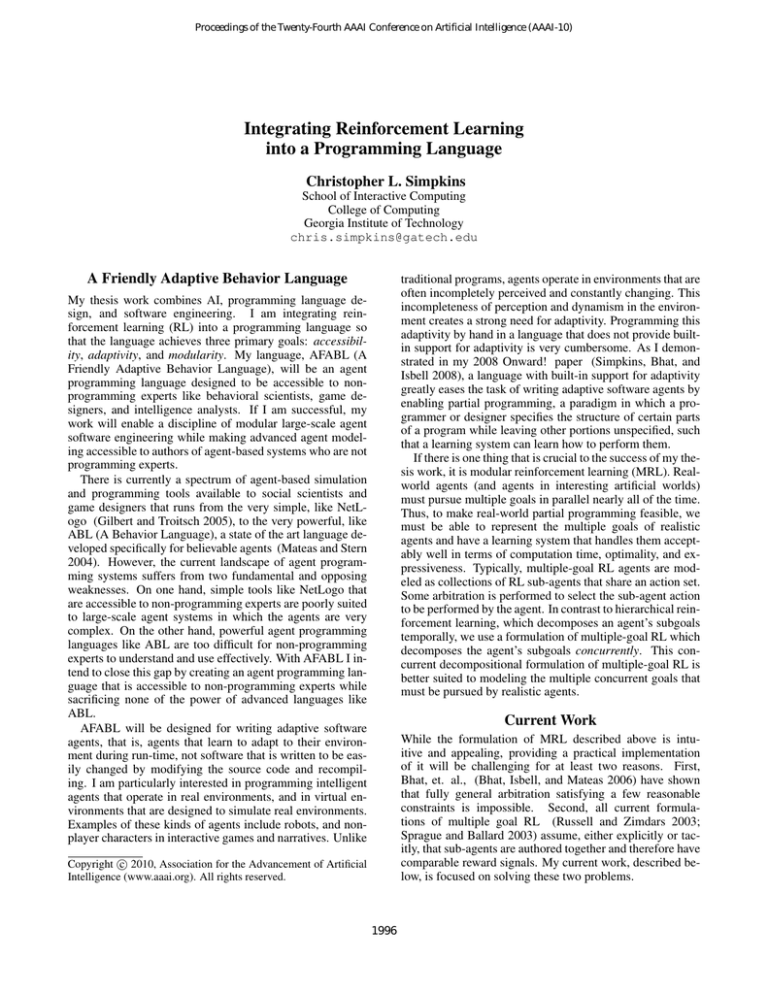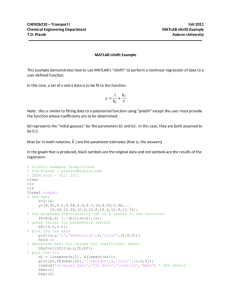
Proceedings of the Twenty-Fourth AAAI Conference on Artificial Intelligence (AAAI-10)
Integrating Reinforcement Learning
into a Programming Language
Christopher L. Simpkins
School of Interactive Computing
College of Computing
Georgia Institute of Technology
chris.simpkins@gatech.edu
A Friendly Adaptive Behavior Language
traditional programs, agents operate in environments that are
often incompletely perceived and constantly changing. This
incompleteness of perception and dynamism in the environment creates a strong need for adaptivity. Programming this
adaptivity by hand in a language that does not provide builtin support for adaptivity is very cumbersome. As I demonstrated in my 2008 Onward! paper (Simpkins, Bhat, and
Isbell 2008), a language with built-in support for adaptivity
greatly eases the task of writing adaptive software agents by
enabling partial programming, a paradigm in which a programmer or designer specifies the structure of certain parts
of a program while leaving other portions unspecified, such
that a learning system can learn how to perform them.
If there is one thing that is crucial to the success of my thesis work, it is modular reinforcement learning (MRL). Realworld agents (and agents in interesting artificial worlds)
must pursue multiple goals in parallel nearly all of the time.
Thus, to make real-world partial programming feasible, we
must be able to represent the multiple goals of realistic
agents and have a learning system that handles them acceptably well in terms of computation time, optimality, and expressiveness. Typically, multiple-goal RL agents are modeled as collections of RL sub-agents that share an action set.
Some arbitration is performed to select the sub-agent action
to be performed by the agent. In contrast to hierarchical reinforcement learning, which decomposes an agent’s subgoals
temporally, we use a formulation of multiple-goal RL which
decomposes the agent’s subgoals concurrently. This concurrent decompositional formulation of multiple-goal RL is
better suited to modeling the multiple concurrent goals that
must be pursued by realistic agents.
My thesis work combines AI, programming language design, and software engineering. I am integrating reinforcement learning (RL) into a programming language so
that the language achieves three primary goals: accessibility, adaptivity, and modularity. My language, AFABL (A
Friendly Adaptive Behavior Language), will be an agent
programming language designed to be accessible to nonprogramming experts like behavioral scientists, game designers, and intelligence analysts. If I am successful, my
work will enable a discipline of modular large-scale agent
software engineering while making advanced agent modeling accessible to authors of agent-based systems who are not
programming experts.
There is currently a spectrum of agent-based simulation
and programming tools available to social scientists and
game designers that runs from the very simple, like NetLogo (Gilbert and Troitsch 2005), to the very powerful, like
ABL (A Behavior Language), a state of the art language developed specifically for believable agents (Mateas and Stern
2004). However, the current landscape of agent programming systems suffers from two fundamental and opposing
weaknesses. On one hand, simple tools like NetLogo that
are accessible to non-programming experts are poorly suited
to large-scale agent systems in which the agents are very
complex. On the other hand, powerful agent programming
languages like ABL are too difficult for non-programming
experts to understand and use effectively. With AFABL I intend to close this gap by creating an agent programming language that is accessible to non-programming experts while
sacrificing none of the power of advanced languages like
ABL.
AFABL will be designed for writing adaptive software
agents, that is, agents that learn to adapt to their environment during run-time, not software that is written to be easily changed by modifying the source code and recompiling. I am particularly interested in programming intelligent
agents that operate in real environments, and in virtual environments that are designed to simulate real environments.
Examples of these kinds of agents include robots, and nonplayer characters in interactive games and narratives. Unlike
Current Work
While the formulation of MRL described above is intuitive and appealing, providing a practical implementation
of it will be challenging for at least two reasons. First,
Bhat, et. al., (Bhat, Isbell, and Mateas 2006) have shown
that fully general arbitration satisfying a few reasonable
constraints is impossible. Second, all current formulations of multiple goal RL (Russell and Zimdars 2003;
Sprague and Ballard 2003) assume, either explicitly or tacitly, that sub-agents are authored together and therefore have
comparable reward signals. My current work, described below, is focused on solving these two problems.
c 2010, Association for the Advancement of Artificial
Copyright Intelligence (www.aaai.org). All rights reserved.
1996
gia Tech’s Tennenbaum Institute who are creating tools for
agent-based organizational simulations (Bodner and Rouse
2009), and I plan to work with Georgia Tech computing professor Mark Riedl in his interactive narrative projects (Riedl
and Stern 2006; Riedl et al. 2008). Both of these collaborations will provide case studies in which I can compare and
contrast agent systems written in ABL with agent systems
written in AFABL. These collaborations will provide two
benefits. First, working with agent modelers will help me
design the language to meet the needs of the kinds of users
I am targeting. Second, their agent systems will provide a
test bed to validate the design of my language. I hope to
show by detailed side-by-side comparison that AFABL significantly reduces the semantic gap between the programming concepts an agent designer must understand to effectively write agent programs, and the behavioral concepts a
non-programmer behavior specialist normally uses to describe intelligent agents such as humans and organizations.
Bhat’s impossibility theorem for ideal arbitration provides
a theoretical framework for designing MRL algorithms: the
first step in designing a practical MRL algorithm is deciding
which constraints of ideal arbitration to relax. Bhat proposes
relaxing the non-dictatorship constraint by creating an arbitrator sub-agent whose task is to combine the preferences of
the other sub-agents to determine the agent’s joint actions.
The arbitrator sub-agent gets its own reward signal which
represents the desirability of a given action for the agent as
a whole, as opposed to the reward signals received by the
other sub-agents that represent desirability with respect only
to their own subtasks. The idea is that the arbitrator will
learn how to combine the sub-agent preferences to achieve a
globally optimal policy for the whole agent.
I am taking a fundamentally different approach to MRL.
I am interested not in theoretical optimality, but in enabling
psychologists, sociologists and game designers to construct
agent systems that model personalities in terms familiar to
behavioral specialists, not programming specialists. A common theme in the behavioral science literature is that personality is composed of multiple components, with personalities
differing in how they weight the different components. (See
(Silverman and Bharathy 2005) for a brief computationallyfocused overview.) These personality components correspond directly to the components in my agent formulation.
Note that I use the term component instead of sub-agent to
reflect the fact that an agent is created by combining components, and because I have an eye toward accommodating
non-RL components in the future.
Specifying the weights on the components of an agent
runs immediately into the problem of reward comparability. If the components of an agent are authored separately,
they cannot be expected to use reward values with similar
scales. For example, one component might use rewards in
the range 1 to 10 while another uses rewards in the range
10 to 100. If these components were combined naively, one
would expect the second component to dominate the first in
specifying the actions chosen by the agent. The central task
of my arbitration algorithm is to learn how to weight these
two components automatically, so that the probability that a
particular component specifies the action taken by the agent
reflects the weights assigned by the agent designer, not the
ratios of the reward scales that each component happens to
use. This point is crucial to truly modular agent software engineering: components must be able to be written separately
without regard to reward comparability.
I expect to have finished developing, analyzing, and testing my MRL algorithm by June 2010 and plan to submit my
results to NIPS. In the next section I discuss the remainder of
my thesis work which uses the MRL system I just described.
References
Bhat, S.; Isbell, C.; and Mateas, M. 2006. On the difficulty of modular reinforcement learning for real-world partial programming. In Proceedings of the Twenty-First National Conference on Artificial Intelligence (AAAI-06).
Bodner, D. A., and Rouse, W. B. 2009. Handbook of Systems Engineering and Management. Wiley. chapter Organizational Simulation.
Gilbert, N., and Troitsch, K. G. 2005. Simulation for the
Social Scientist. Berkshire, England: Open University Press,
McGraw-Hill Education.
Mateas, M., and Stern, A. 2004. Life-like Characters. Tools,
Affective Functions and Applications. Springer. chapter A
Behavior Language: Joint Action and Behavioral Idioms.
Riedl, M. O., and Stern, A. 2006. Believable agents and intelligent scenario direction for social and cultural leadership
training. In Proceedings of the 15th Conference on Behavior
Representation in Modeling and Simulation.
Riedl, M. O.; Stern, A.; Dini, D.; and Alderman, J. 2008.
Dynamic experience management in virtual worlds for entertainment, education, and training. In International Transactions on Systems Science and Applications, Special Issue
on Agent Based Systems for Human Learning, volume 4(2).
Russell, S., and Zimdars, A. L. 2003. Q-decomposition for
reinforcement learning agents. In Proceedings of the Twentieth International Conference on Machine Learning (ICML2003).
Silverman, B. G., and Bharathy, G. K. 2005. Modeling
the personality and cognition of leaders. Technical report,
University of Pennsylvania, Philadelphia, PA.
Simpkins, C.; Bhat, S.; and Isbell, C. 2008. Towards
adaptive programming: Integrating reinforcement learning
into a programming language. In OOPSLA ’08: ACM SIGPLAN Conference on Object-Oriented Programming, Systems, Languages, and Applications, Onward! Track.
Sprague, N., and Ballard, D. 2003. Multiple-goal reinforcement learning with modular sarsa.
Future Work
While the syntax of AFABL will be different from the examples presented in my previous Onward! paper, the essential
idea of adaptive programming remains the same. To finish
my dissertation I will flesh out my new language by working
with behavioral scientists, simulationists, and game designers. To this end I have been working with a group of industrial and systems engineers led by Dr. Doug Bodner at Geor-
1997










